
Structural material
Encyclopedia
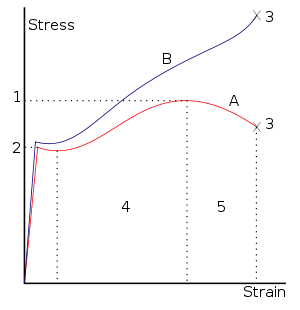
Common structural materials are:
Wrought iron
Wrought iron is the simplest form of iron, and is almost pure iron (typically less than 0.15% carbon). It usually contains some slagSlag
Slag is a partially vitreous by-product of smelting ore to separate the metal fraction from the unwanted fraction. It can usually be considered to be a mixture of metal oxides and silicon dioxide. However, slags can contain metal sulfides and metal atoms in the elemental form...
. Its uses are almost entirely obsolete, and it is no longer commercially produced.
Wrought iron is very poor in fires. It is ductile, malleable and tough. It does not corrode
Corrosion
Corrosion is the disintegration of an engineered material into its constituent atoms due to chemical reactions with its surroundings. In the most common use of the word, this means electrochemical oxidation of metals in reaction with an oxidant such as oxygen...
as easily as steel.
Cast iron
Cast iron is a brittle form of iron which is weaker in tension than in compression. It has a relatively low melting point, good fluidity, castability, excellent machinability and wear resistance. Though almost entirely replaced by steel in building structures, cast irons have become an engineering material with a wide range of applications, including pipes, machine and car parts.Cast iron retains high strength in fires, despite its low melting point. It is usually around 95% iron, with between 2.1-4% carbon and between 1-3% silicon. It does not corrode as easily as steel.
Steel
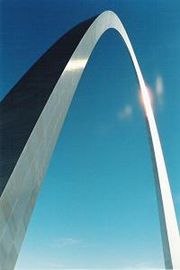
Steel is used extremely widely in all types of structures, due to its relatively low cost, high strength to weight ratio and speed of construction.
Steel is a ductile material, which will behave elastically until it reaches yield (point 2 on the stress-strain curve), when it becomes plastic and will fail in a ductile manner (large strains, or extensions, before fracture at point 3 on the curve). Steel is equally strong in tension and compression.
Steel is weak in fires, and must be protected in most buildings. Despite its high strength to weight ratio, steel buildings have as much thermal mass as similar concrete buildings.
The elastic modulus
Elastic modulus
An elastic modulus, or modulus of elasticity, is the mathematical description of an object or substance's tendency to be deformed elastically when a force is applied to it...
of steel is approximately 205 GPa
Steel is very prone to corrosion (rust
Rust
Rust is a general term for a series of iron oxides. In colloquial usage, the term is applied to red oxides, formed by the reaction of iron and oxygen in the presence of water or air moisture...
).
Stainless steel
Stainless steel is an iron-carbon alloy with a minimum of 10.5% chromium content. There are different types of stainless steel, containing different proportions of iron, carbon, molybdenumMolybdenum
Molybdenum , is a Group 6 chemical element with the symbol Mo and atomic number 42. The name is from Neo-Latin Molybdaenum, from Ancient Greek , meaning lead, itself proposed as a loanword from Anatolian Luvian and Lydian languages, since its ores were confused with lead ores...
, nickel
Nickel
Nickel is a chemical element with the chemical symbol Ni and atomic number 28. It is a silvery-white lustrous metal with a slight golden tinge. Nickel belongs to the transition metals and is hard and ductile...
. It has similar structural properties to steel, although its strength varies significantly.
It is rarely used for primary structure, and more for architectural finishes and building cladding.
It is highly resistant to corrosion and staining.
Concrete
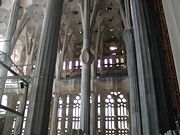
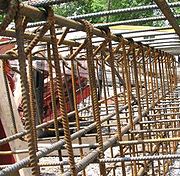
Concrete is a non-linear, non-elastic and brittle material. It is strong in compression and very weak in tension. It behaves non-linearly at all times. Because it has essentially zero strength in tension, it is almost always used as reinforced concrete
Reinforced concrete
Reinforced concrete is concrete in which reinforcement bars , reinforcement grids, plates or fibers have been incorporated to strengthen the concrete in tension. It was invented by French gardener Joseph Monier in 1849 and patented in 1867. The term Ferro Concrete refers only to concrete that is...
, a composite material. It is a mixture of sand
Sand
Sand is a naturally occurring granular material composed of finely divided rock and mineral particles.The composition of sand is highly variable, depending on the local rock sources and conditions, but the most common constituent of sand in inland continental settings and non-tropical coastal...
, aggregate, cement
Cement
In the most general sense of the word, a cement is a binder, a substance that sets and hardens independently, and can bind other materials together. The word "cement" traces to the Romans, who used the term opus caementicium to describe masonry resembling modern concrete that was made from crushed...
and water. It is placed in a mould, or form, as a liquid, and then it sets (goes off), due to a chemical reaction between the water and cement. The hardening of the concrete is called curing. The reaction is exothermic (gives off heat).
Concrete increases in strength continually from the day it is cast. Assuming it is not cast under water or in constantly 100% relative humidity, it shrinks over time as it dries out, and it deforms over time due to a phenomenon called creep
Creep (deformation)
In materials science, creep is the tendency of a solid material to slowly move or deform permanently under the influence of stresses. It occurs as a result of long term exposure to high levels of stress that are below the yield strength of the material....
. Its strength depends highly on how it is mixed, poured, cast, compacted, cured (kept wet while setting), and whether or not any admixtures were used in the mix. It can be cast into any shape that a form can be made for. Its colour, quality, and finish depend upon the complexity of the structure, the material used for the form, and the skill of the worker.
The elastic modulus
Elastic modulus
An elastic modulus, or modulus of elasticity, is the mathematical description of an object or substance's tendency to be deformed elastically when a force is applied to it...
of concrete can vary widely and depends on the concrete mix, age, and quality, as well as on the type and duration of loading applied to it. It is usually taken as approximately 25 GPa for long-term loads once it has attained its full strength (usually considered to be at 28 days after casting). It is taken as approximately 38 GPa for very short-term loading, such as footfalls.
Concrete has very favourable properties in fire - it is not adversely affected by fire until it reaches very high temperatures. It also has very high mass, so it is good for providing sound insulation and heat retention (leading to lower energy requirements for the heating of concrete buildings). This is offset by the fact that producing and transporting concrete is very energy intensive.
Reinforced concrete
Reinforced concrete is concrete in which steel reinforcement bars ("rebars"), plates or fibers have been incorporated to strengthen a material that would otherwise be brittle. In industrialised countries, nearly all concrete used in construction is reinforced concrete. Due to its weakness in tension capacity, concrete will fail suddenly and in brittle manner under flexural (bending) or tensile force unless adequately reinforced with steel.Prestressed concrete
Prestressed concrete is a method for overcoming the concreteConcrete
Concrete is a composite construction material, composed of cement and other cementitious materials such as fly ash and slag cement, aggregate , water and chemical admixtures.The word concrete comes from the Latin word...
's natural weakness in tension
Tension (mechanics)
In physics, tension is the magnitude of the pulling force exerted by a string, cable, chain, or similar object on another object. It is the opposite of compression. As tension is the magnitude of a force, it is measured in newtons and is always measured parallel to the string on which it applies...
. It can be used to produce beam
Beam (structure)
A beam is a horizontal structural element that is capable of withstanding load primarily by resisting bending. The bending force induced into the material of the beam as a result of the external loads, own weight, span and external reactions to these loads is called a bending moment.- Overview...
s, floor
Floor
A floor is the walking surface of a room or vehicle. Floors vary from simple dirt in a cave to many-layered surfaces using modern technology...
s or bridge
Bridge
A bridge is a structure built to span physical obstacles such as a body of water, valley, or road, for the purpose of providing passage over the obstacle...
s with a longer span
Span (architecture)
Span is the distance between two intermediate supports for a structure, e.g. a beam or a bridge.A span can be closed by a solid beam or of a rope...
than is practical with ordinary reinforced concrete
Reinforced concrete
Reinforced concrete is concrete in which reinforcement bars , reinforcement grids, plates or fibers have been incorporated to strengthen the concrete in tension. It was invented by French gardener Joseph Monier in 1849 and patented in 1867. The term Ferro Concrete refers only to concrete that is...
. Prestressing tendons (generally of high tensile
Tension (mechanics)
In physics, tension is the magnitude of the pulling force exerted by a string, cable, chain, or similar object on another object. It is the opposite of compression. As tension is the magnitude of a force, it is measured in newtons and is always measured parallel to the string on which it applies...
steel
Steel
Steel is an alloy that consists mostly of iron and has a carbon content between 0.2% and 2.1% by weight, depending on the grade. Carbon is the most common alloying material for iron, but various other alloying elements are used, such as manganese, chromium, vanadium, and tungsten...
cable
Cable
A cable is two or more wires running side by side and bonded, twisted or braided together to form a single assembly. In mechanics cables, otherwise known as wire ropes, are used for lifting, hauling and towing or conveying force through tension. In electrical engineering cables are used to carry...
or rods) are used to provide a clamping load which produces a compressive stress that offsets the tensile stress that the concrete compression member
Compression member
A compression member is a general class of structural elements of which a column is the most common specific example.-Description:For a compression member, such as a column, the principal stress comes mainly from axial forces, that is forces that fall along one line, usually the centerline.The...
would otherwise experience due to a bending load.
Aluminium

Corrosion resistance is excellent due to a thin surface layer of aluminium oxide that forms when the metal is exposed to air, effectively preventing further oxidation. The strongest aluminium alloys are less corrosion resistant due to galvanic reactions with alloyed copper.
Aluminium is used in some building structures (mainly in facades) and very widely in aircraft engineering because of its good strength to weight ratio. It is a relatively expensive material.
In aircraft it is gradually being replaced by carbon composite materials.
Composites
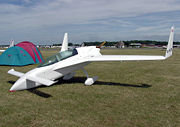
Coalport
Coalport is a village in Shropshire, now part of the new town of Telford. It is located on the River Severn at , a mile downstream of Ironbridge...
cast iron bridge built in 1818. Composites are often anisotropic (they have different material properties in different directions) as they can be laminar materials. They most often behave non-linearly and will fail in a brittle manner when overloaded.
They provide extremely good strength to weight ratios, but are also very expensive. The manufacturing processes, which are often extrusion, do not currently provide the economical flexibility that concrete or steel provide. The most commonly used in structural applications are glass-reinforced plastic
Glass-reinforced plastic
Fiberglass , is a fiber reinforced polymer made of a plastic matrix reinforced by fine fibers of glass. It is also known as GFK ....
s.
Masonry
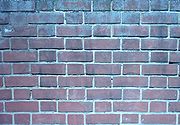
Mortar (masonry)
Mortar is a workable paste used to bind construction blocks together and fill the gaps between them. The blocks may be stone, brick, cinder blocks, etc. Mortar becomes hard when it sets, resulting in a rigid aggregate structure. Modern mortars are typically made from a mixture of sand, a binder...
between bricks or blocks is unable to carry tension). Because it cannot carry structural tension, it also cannot carry bending, so masonry walls become unstable at relatively small heights. High masonry structures require stabilisation against lateral loads from buttress
Buttress
A buttress is an architectural structure built against or projecting from a wall which serves to support or reinforce the wall...
es (as with the flying buttress
Flying buttress
A flying buttress is a specific form of buttressing most strongly associated with Gothic church architecture. The purpose of any buttress is to resist the lateral forces pushing a wall outwards by redirecting them to the ground...
es seen in many European medieval churches) or from windposts.
Historically masonry was constructed with no mortar or with lime mortar. In modern times cement based mortars are used. The mortar glues the blocks together, and also smooths out the interface between the blocks, avoiding localised point loads that might have led to cracking.
Since the widespread use of concrete, stone is rarely used as a primary structural material, often only appearing as a cladding, because of its cost and the high skills needed to produce it. Brick and concrete blockwork have taken its place.
Masonry, like concrete, has good sound insulation properties and high thermal mass, but is generally less energy intensive to produce. It is just as energy intensive as concrete to transport.
Timber
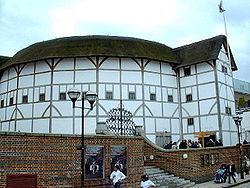
Wood is strong in tension and compression, but can be weak in bending due to its fibrous structure. Wood is relatively good in fire as it chars, which provides the wood in the centre of the element with some protection and allows the structure to retain some strength for a reasonable length of time.
Other structural materials
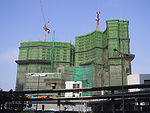
- AdobeAdobeAdobe is a natural building material made from sand, clay, water, and some kind of fibrous or organic material , which the builders shape into bricks using frames and dry in the sun. Adobe buildings are similar to cob and mudbrick buildings. Adobe structures are extremely durable, and account for...
- AlloyAlloyAn alloy is a mixture or metallic solid solution composed of two or more elements. Complete solid solution alloys give single solid phase microstructure, while partial solutions give two or more phases that may or may not be homogeneous in distribution, depending on thermal history...
- BambooBambooBamboo is a group of perennial evergreens in the true grass family Poaceae, subfamily Bambusoideae, tribe Bambuseae. Giant bamboos are the largest members of the grass family....
- Carbon fibre
- Fiber reinforced plastic
- MudbrickMudbrickA mudbrick is a firefree brick, made of a mixture of clay, mud, sand, and water mixed with a binding material such as rice husks or straw. They use a stiff mixture and let them dry in the sun for 25 days....
- Roofing materials

